How to lay cementitious waterproofing coating with your own hands in a proper way. Do not make mistakes!
What is cementitious waterproofing? It is the most popular roofing material, which has 1-in-1 quality – it is the coating and the waterproofing. An important decision while building a house is the choice of the roofing material. If you want to lay it with your own hands, it is important to choose the material for the roof with the following characteristics:
- durability;
- eco-friendliness;
- frost-resistance;
- simple installation.
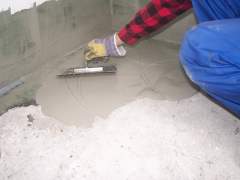 Advantages of cementitious waterproofing system:
Advantages of cementitious waterproofing system:
- protection from solar radiation;
- high resistance to mechanical stress (pressure of the snow cover);
- high resistance to temperature extremes;
- high water resistance – it is the excellent protection from rain;
- fire protection;
- lightweight;
- durability (up to 50 years);
- absorption of noise in the rain;
- no need for additional vapor barrier;
- the ability to be painted.
All these features made the cementitious coating the most popular among other not so expensive products of this kind (the crystalline one is the cheapest).
It also has some disadvantages:
- in the shadow it may become covered with lichens after some time;
- it is rather fragile and unsuitable for transportation;
- it is super fragile while walking on it (if you have to walk through the roof – walk very carefully).
Preparing the roof
When the rafters are installed and the material is selected, it’s time to start preparing the roof for laying the cementitious coating.
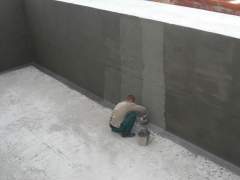 It is necessary to set the film which will be the hydro barrier. The film should be fixed to the rafters using a staple gun. The hydro barrier is needed in order to prevent moisture from the melted snow that can sweep under the coating. Also the rain, dripping down through the film, can cause damage to your house. The film is rolled out and then it is immediately fixed to the rafters. The film should be rolled horizontally and you should start from the bottom of the roof. The horizontal overlap should be at least 6 inches, and the vertical overlap should be no less than 5 inches.
It is necessary to set the film which will be the hydro barrier. The film should be fixed to the rafters using a staple gun. The hydro barrier is needed in order to prevent moisture from the melted snow that can sweep under the coating. Also the rain, dripping down through the film, can cause damage to your house. The film is rolled out and then it is immediately fixed to the rafters. The film should be rolled horizontally and you should start from the bottom of the roof. The horizontal overlap should be at least 6 inches, and the vertical overlap should be no less than 5 inches.- Then set the counter-rail. Take the rail with the width of about 2 inches and the height of about 1-1,5 inches. For the lathing take edging boards with the width of about 4 inches and the height of about 1 inch. The counter-rail and the lathing are attached to the rafters with conventional nails. The lathing boards are nailed according to the following rule: three boards for each sheet of cementitious coating – for the under part of the sheet, for the top part and for the middle part.
- Across the slope of the roof the overlapping “wave” of the sheet of the cementitious coating should overlap the edges of each adjacent sheet. The overlap must be not less than 6 inches and not more than 12 inches.
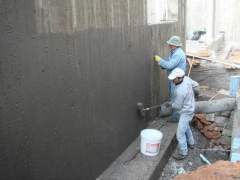 If you need to reduce the size of a sheet of cementitious coating or cut off a corner of the sheet during its installation, before starting the cutting it is better to soak the place of cutting with water. While cutting necessarily use a dust mask and goggles – getting into the lungs the dust has a very detrimental effect on the body. Wetting the place of the cuеting allows to reduce the amount of dust.
If you need to reduce the size of a sheet of cementitious coating or cut off a corner of the sheet during its installation, before starting the cutting it is better to soak the place of cutting with water. While cutting necessarily use a dust mask and goggles – getting into the lungs the dust has a very detrimental effect on the body. Wetting the place of the cuеting allows to reduce the amount of dust.- The cementitious coating can be cut with a hand saw or a disc grinder with the stone. It is also possible to make pre-drawn lines and then, using a nail and a hammer, to make a series of holes at a distance of about 10-15 mm – and then break off a part of the cementitious coating. The fracture may be uneven, but you get the super minimum of dust.
- Now, when you exactly know the number of rows of cementitious coating and its overlap, mark up the roof to the right to the rail to nail the boards for fixing the cementitious coating.
- Above the gable you should release the board from with some reserve (about 2 inches). Then cut the board, pulling the marking thread upwards along the gable.
Installing properly
- The cementitious coating should be laid starting from the bottom row.
- After the laying of four sheets of the cementitious coating (the two in the first row and the two in the second row; the rows are arranged one above the other) in the place of their intersection the large gaps may appear. To avoid this you need to cut the corners of the cementitious coating constantly during the process of laying.
- The row sheets must be cut. You should cut off the opposite corners diagonally. At the same time the eaves sheets, the ridge sheets and the edge sheets must have only one cut corner. The corners of the initial eaves sheets and the final ridge sheets of the cementitious coating are not cut.
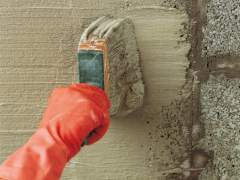 The cementitious coating is fixed with special galvanized nails – 2-3 nails for each sheet of the cementitious coating. The nails are driven into the upper part of the “wave” of the sheet. Previously you should drill a hole at the attachment point, which has a slightly larger diameter than the nail. This will ensure the mobility of the cementitious coating during the temperature changes.
The cementitious coating is fixed with special galvanized nails – 2-3 nails for each sheet of the cementitious coating. The nails are driven into the upper part of the “wave” of the sheet. Previously you should drill a hole at the attachment point, which has a slightly larger diameter than the nail. This will ensure the mobility of the cementitious coating during the temperature changes.- For the roofing ridge you can use the ready-made element or any galvanizing sheet. The sheet needs to be cut along its length, the width of the narrow bars you long to get at the end should be about 3 inches. If you can’t bend the galvanizing sheet, you can order this at any tin shop.
- When laying the cementitious coating do not forget to make an overlap of about 4 inches.
We hope this article helped you to get the necessary information on cementitious waterproofing and the proper way of installing it.
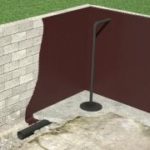
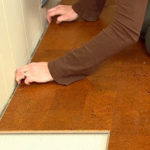


Cement waterproofing – important tips on installation